|
For generations Somavaunshiya Sahasrarjun Kshatriaya (SSK) genealogy is historically maintained by the Bhats. They visit the SSK family homes at convenient intervals. They identify each family with their gotras, relate them to their ancestral royal heritage and read the family history from their written books called Potis. They update the current birth and death records of every family they visit. To entertain, educate and instill pride in SSK heritage they also quote many folklores written in their Potis. They also evoke pouranic episodes related to Sahasrarjun. Many of ancestral and mythological past folkores come from word of mouth and Puranas. It is interesting to note Bhats are the main source of any written past.It is every SSKian pride and heritage to know their past ancestral roots and pass on to their children. This type of ancestral information will bond the community living apart. For the benefit of the foreign born SSK children, I have briefly presented here with the simple illustrations these folklores. These stories are directly related to Sahasrarjun our Patriarch, and Hinglajimata our Kuldevata. More stories will be illuminated as they are available. Bhats claim they have maintained SSK family records since the birth of our patriarch Rajrajeshwar Kartiviryarjun. The earlier records kept by Bhats were written on dried leaves, on wooden boards, or on clothes etc. These old improperly kept records were approximated. Many times no proper dates or family birth or deaths were recorded. Displaced from Mandavagad later generations of Bhats with divided geographic responsibly were either did not know how to maintain such a high volume of old Potis or they had economic reasons. Even I have heard another rumor from leading community leaders that the safely stored in wooden containers of old Potis were burnt to ashes during hindu muslim rivalry encouraged by invading Moghal conquerors. The current Bhat claim that remaining ones are too fragile to carry around. They have lost moisture, and have become deteriorated and brittle. To open these records they have to sprinkle them with water to soften. Presently these are bundled and stacked on the shelves at the homes of Bhats in Rajasthan. Bhats protect the privacy of these records. They say the records were in Modi (Nagarik lipi) script, which has a tendency to change with time. They have been kept under strict privacy, they claim their livelihood depends on them. The present Bhats carry around an updated and properly documented version of thousand year of SSK history record books (potis). Bhats reason that a thousand years ago Kshatriya community basically dissolved at Mandwagad, where our ancestors had ruled for generations. Our community lacked unity and had developed antagonisms with powerful Brahmin community. Added to this were Muslim invasions caused terror they had never seen. The breaking points came when Muslim conquerors chased after our SSK beautiful women. Not accepting this type of behavior SSK families in a mass migration moved out of Mandawagad( Maheshwar in MP) initially settled in south and elsewhere. In search of a secure life and looking for new business opportunities many have wandered and migrated to various locations ever since. These families left Mandawagad moved first to Gujarath. Many divided families ventured in to new territories. They proceeded to Maharashtra and further down south to Karnatak. From Bijapur, they branched out. Within the families, few went to Bhagyanagar (Hyderabad), other regions of Karnatak and southern Maharashtra. Some proceeded to northern regions of India such as Bihar up to Nepal. Bhats say our Kshatriya community elsewhere is addressed as Rajputs, Khatries, Khats. Major SSK settlements are in the regions Karnak, Hyderabad (Andra Pradesh), Maharashtra, Tamil Nadu and Gujarath regions. Bhat families, among themselves, have allotted various geographic regions. Their tour lasts 2-3 months. This cycle repeats to other regions. On completion of their tour they return to Rajasthan and rest. They seem to take a big break after they complete all the tours, each planned tour is limited by how many heavy records they can carry, the geographic area they cover and our population density in the chosen region. The family histories are all hand written and are kept in bound books (Poti). The heavily used or damaged pages are copied and then duplicated in loosely bound packages. On arrival to the chosen geographic region, they contact the local leaders ( Samaj panchas) of SSK communities, who make their boarding arrangements at their Samaj Temples or Dharmashala rooms. They send the community messenger to announce the local families of their arrival. Bhats request the SSK families to invite them on voluntary basis to their homes. At the SSK homes, family members gather around to attend the ceremonial puja of their records (pothis). Bhats then identify the families with their gotras, relate them to their ancestral royal heritage. They update the family birth and death records regularly. Then they chant the family history.The information for this article was collected from our Bhat Maluji and his son Mohan Chavan of Dadota, District Nayor, Rajasthan, India, at their North Karnatak camp on February 2007. Formerly this family covered Gujarath region. Their late uncle Indrajitasa Chavan of Lahogava, Parabhani( Maharashtra) covered southern states such as Karnatak and Maharashsta. |
STORY OF SAHARJUN'S CHILDRENAfter the departure of our patriarch Sahasrarjun, looming fear of Parashuram forced the sons and grandsons to gather their weapons and depart from their palaces. 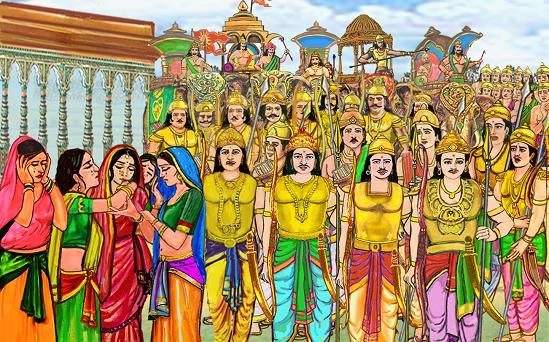
|
They headed to the forest ashram of Chyavan rishi and made arrangements to store their heavy weapons in the grass huts possibly either to use at later date or to send a message to Parashuram indirectly their passivity, and lack of desire to combat with him directly. 
|
Seeking urgent shelter, they proceeded directly to Janaka raj of Nepal. At the palace of Janaka Raja, they pleaded with the king to provide the shelter from Parashurams atrocity. 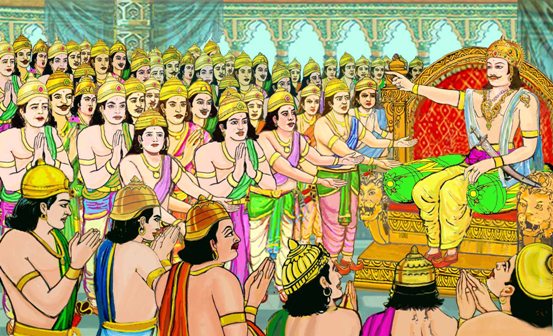
|
Janak Raja fearing for his own dear life, advised them that they will be better served if they proceed to the dark Hingla caves, and pray Kuldevata Hinglajimata for protection.These dark caves are situated in the desert mountain region of Balachustan 275 Km south of Karachi, Pakistan on the banks of Hingol river. 
|
Sahasrarjuns descendants arrived at the dark caves. They prayed to Hinglaji matha. They sacrificed sheeps and goats as an offering to Hinglajimata puja.Goddess mata was pleased at their dedication and gave an audience. The Sahasrarjun children begged her to protect them from sure death by Parashuram. She advised them to return and deposit the remaining small weapons at the Chyavan rishi ashram.They complied. 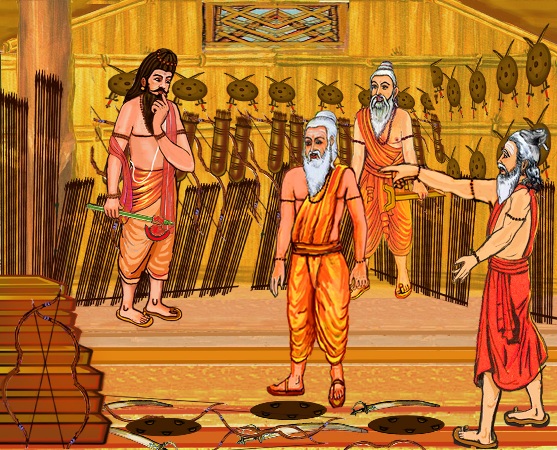
|
One day Parashuram walked in to the ashram of Chyavan rishi and visited the weapon warehoused huts. He was shocked to find the store of weapons. The monks at ashram fearfully explained the recent revisit of Sahasrarjun descendants . 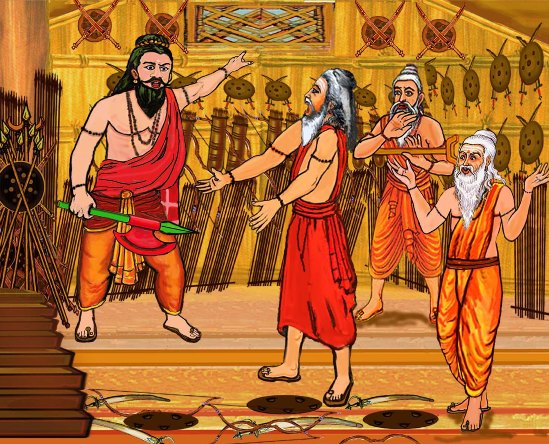
|
|
This annoyed Parashuram, because the reason did not convince him. He wanted to confirm for himself they were not hiding weapons. He proceeded towards the Hinglaj caves. 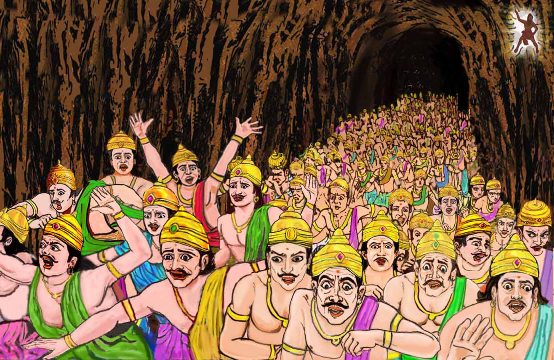
|
|
This terrible life threatening news of Parashuram’s anticipated visit to the caves, hit the Kshatriyas like bolt from blue, a few scared groups ran out of the caves. They were addressed as Bhavasars. 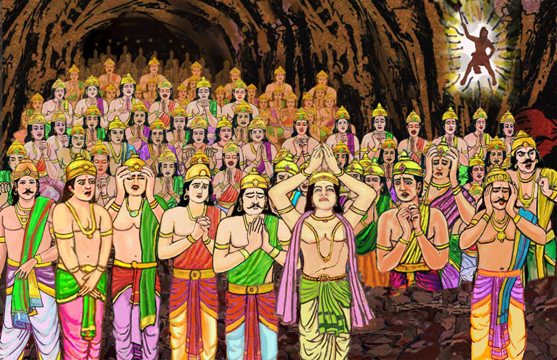
|
Some of them were so scared they went deep into the cave tunnels and hid behind boulders. They were called Shimpis. 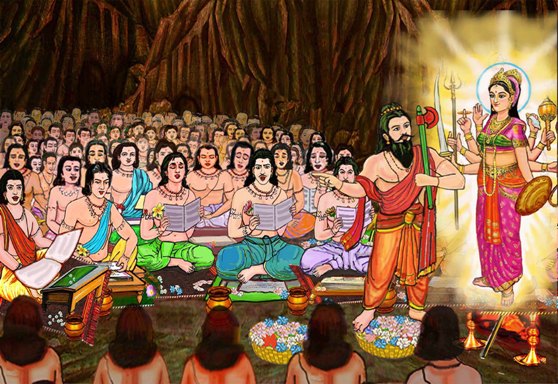
|
The remaining Kshatriyas stayed back and started praying Hinglagimata.. Mata referred to them as Khatries. Bhats claim that Sahasrarjun had 108 wives. Bhavasars and Shimpis were borne to the 6 wives of Sahasrarjun. Today they are in much larger number than Khatries. As expected, Parashuram arrived at the caves. He noticed many Ksatriyas were sitting calmly, wearing Janni across their shoulder. They held flower in their hands. Their mounth chanting verses of Gayatrimantra. Parashuram was puzzled. Apparently was expecting some armed resistance. Parashuram looked towards Mata to seek the answer. She explained to him that they were Khahtris and have denounced all weapons. They will no longer wish to fight. Bhats even expressed that Parashuram gathered all the offspring’s of Sahasrarjun at the caves, and taught them new trades. He taught Khatries how to weave clothes, Bavasars how to color the yarn and fabric and Shimpis how to sew the clothes. This weaving trade has been practiced in many SSK communities for generations ever since. Starting from Mandawagad,( Maheshwar in MP), down all the way to South India, to date many Khatries still weave saries. Many trade commodities related to looms and sarees. My family inherited the trade of weaving sarees and sale. They hire weavers and manufacture large scale sarees and promote them in the market place. 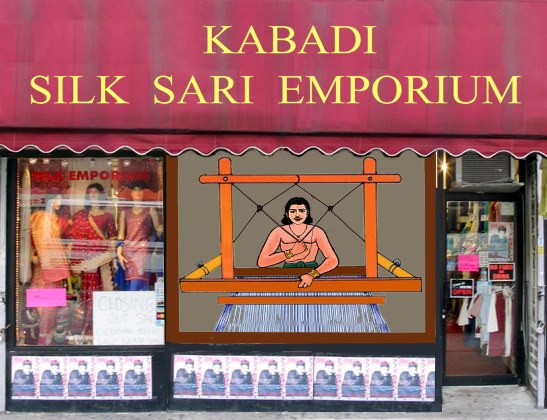
Today our community is progressive and thinking ahead in to new trades traveled to foreign lands. |
THE STORY OF KHATRI KING OF GUJARATHOnce there was a powerful and arrogant Kshatriya king ruled Gujarath. During a Navaratri festival there was a huge Garaba dance at his palace. The palace was well lit and decorated. It had a full festival atmosphere, there was a loud music the air was filled with laughter, a round Garba dance was going on. 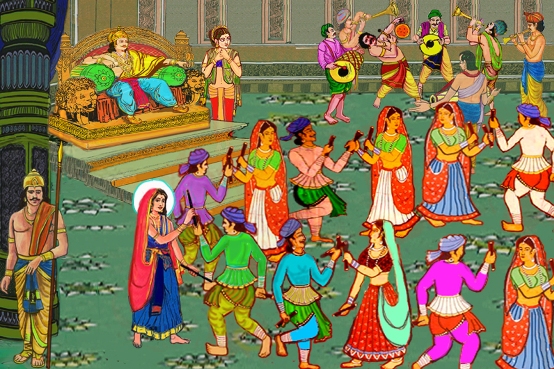
|
|
Hinglaji Mata appeared at the Garba on the first day . The king and his queen noticed the radiant beauty standing at the pillar, watching the dance. On the second day at the Garba the king inquired with the queen about the presence of a mysterious beauty. The queen also did not know her identity. They were in a quandary. 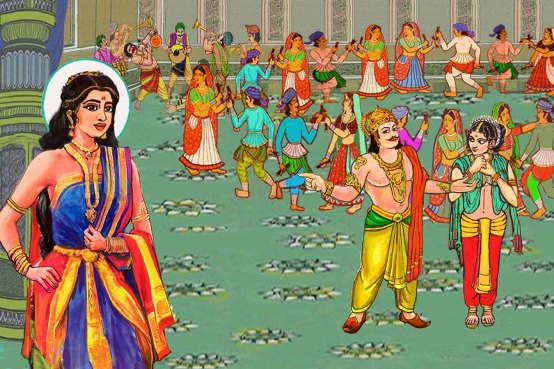
|
|
The king decided the next day to solve the mystery. He dressed as a palace guard and entered the Garba hall. He approached devi standing at the piller head on, he gripped her hand tight as he owned every woman in the Garba, and asked her to marry him. Devi got offended and told him that “I am goddess I can bless you, I can offer you a large kingdom or wealth or land or many wives or children” but no marriage. The king aggressively stepped forward, squeezed and pulled her hand hard and forced her. 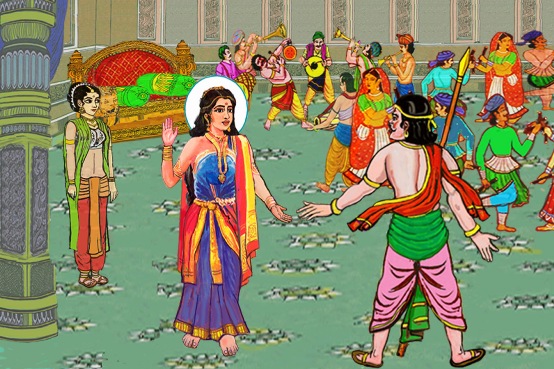
|
|
Hinglaji mata became furious at the kings arrogant behavior. The ground opened under her feet, with her finger pointing at the king, spelled a curse- “henceforth no SSKan will ever be a king or hold a high power position in society or rule other people”. 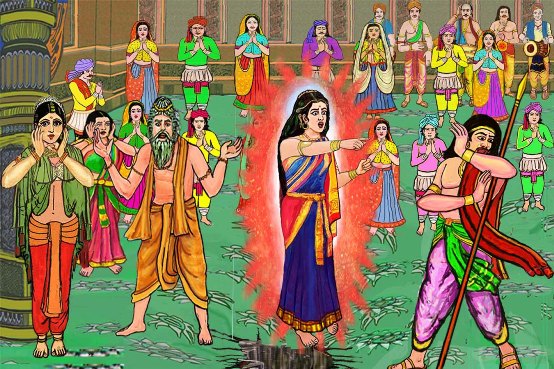
|
|
The earth underneath trembled and opened wide. As she descended into the Bhumatas womb, suddenly Vishwamitra standing nearby realized this dire situation. He grasped her gently and held her hair and pleaded Mata to pardon the community. 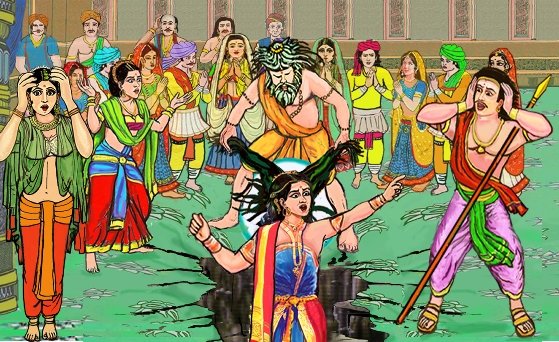
|
|
Vishwamatra uttered Devi it is one mans wild mistake, the community should not be held captive. She was pleased at Vishwamitras plea and promised him that now my Hingla Mata avatar is complete, I will return as a goddess Ambabhavani. As she disappeared into the ground, her radiant image grew projecting the Image of Ambabhavani. Every one was pleased. 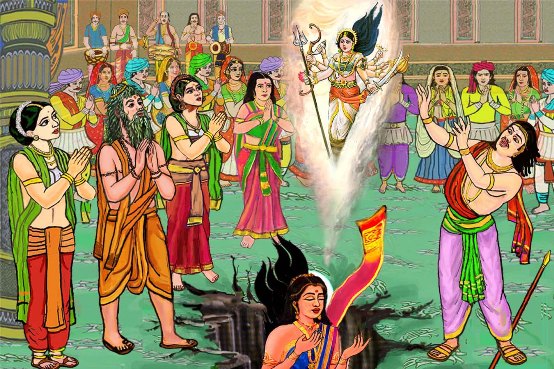
|
|
Ambabhavani showed herself and blessed every one. Jaya Jagadamba.
|
|
Across India there are many folklores told related to arrogant Ravana and how Sahasrarjuna humbled him. Here is the Bhats version of it.One summer Sahasrarjun went to worship at the most revered lingu of Onkareshwar on the bank of Narmada river. He got down to bathe at Narmada. The water stream was slow and narrow; he suddenly took a gigantic avatar and laid across the narrow stream blocking the river flow. The water formed a lake on the North side, and on the South side there was an overflow on both sides of the head and feet of Sahasrarjun. 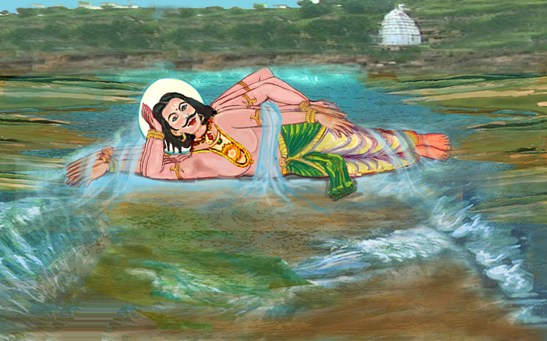
|
|
Further down South on the same Narmada river bank, Ravan was performing Shiva puja.Sudden blockage and channeling of river flow out of the river bank annoyed Ravana, as he could not concentrate. It angered him. 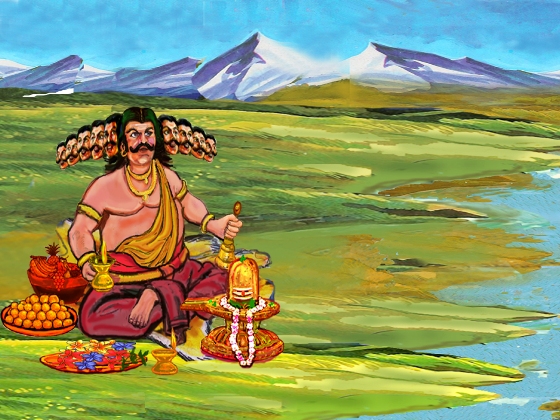
|
|
He screamed from the top of his head and declared he will punish who ever is responsible for this act. As he proceeded to the North of the river he found Sahasrarjun laying across the river and blocking the water flow. 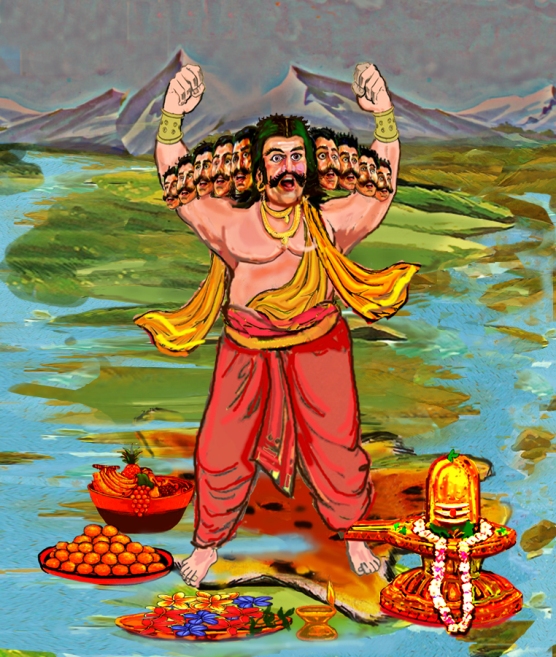
|
|
He challenged Sahasrarjun to a duel. There was a huge collision. As per Bhats Ravana appeared as a tiny wild beast or a monkey to a gigantic Sahasrarjun. 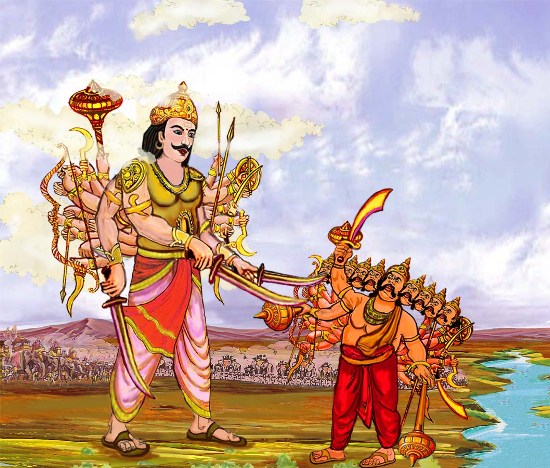
|
|
He picked up and manhandled Ravana. He tied him with the pasha He then carried him to the kingdom at Maheshwar. 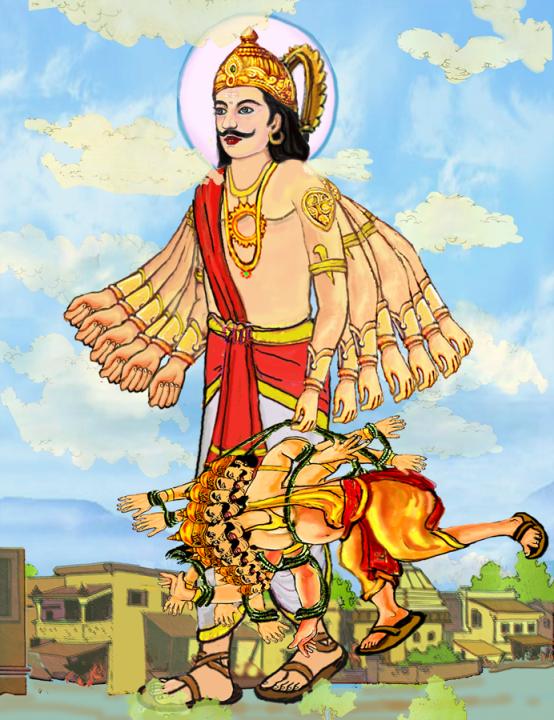
|
|
He imprisoned him in a dark room so Ravana would have repentance. 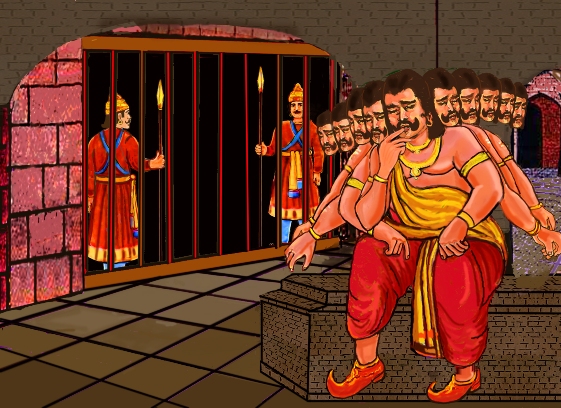
|
|
His queens took their turns decorating him with the lit oil lamps. They placed lamps on his head and one in a hand in an open Darbar. Ravana was truly humiliated and humbled. 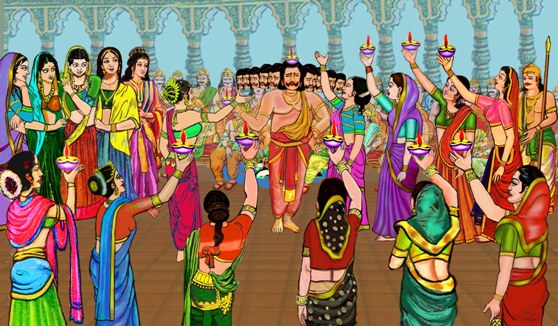
|
|
Ravana’s grand uncle saint Pulastaya came to rescue Ravana from further humiliation. He pleaded with the Sahasrarjun to release Ravana. His request was honored. Sahasrarjun released Ravana in the custody of saint Pulastaya. 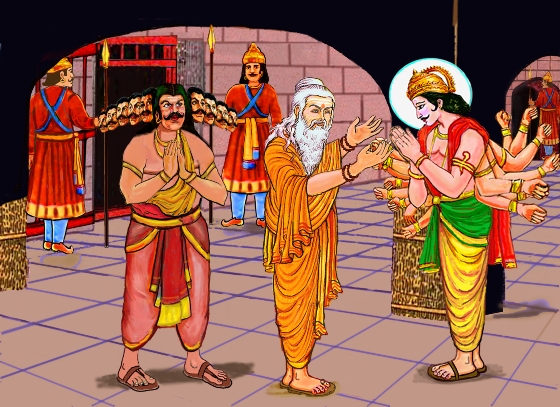
|
|
Bhats Potis donot recognize other large Sahasrarjunian groups who claim to be the descendants of Sahasrarjun such as Jayalshwals. The Bhats potis donot relate to Hai Haya lineage at all. Sahasrarjuns family tree is very dwarf. Kartiviryarjun was only 6-7 generations away from rishi Atri and Brahma. Looking at internet articles related to Somavaunsha Sahasrarjun Kshatriya many hindus worship Hinglajimata. Their religious practices are related to their geographic location and beliefs in society. There are Bhavasars in Gujarath who have converted to Jainism. Some since the time of Parashurama remained Brahmo Kshatriyas they practice Brahmin rituals. Many Bhavasars remained Kshatriyas. Some were forced to become muslims.There are even articles indicating that Parsis (Zorashtrihans) were Kshatriyas migrated to Iran to get away from Parashuram attacks. During Muslim invasion of Iran, they returned back to Gujarath their original homeland. In the authors opinion the best way to unite all the Saharjunians outside SSK community is to carry out the genetic study of key groups. Obtain genetic information identify the Arjunine marker gene. This will unite all the Sahasrarjunians because all the true descendants of Sahasrarjun carry this Arjunine gene. The data can be inserted into the established gene data banks (gene pools). For instance a huge databank is created by Parsis and many Brahmin groups in India. The large bank of Jews is available from Europe for reference etc. These small communities have faced chronic inbreeding, resulting in the low growth of the population. On the way they try to do early research so that they can establish defective genes passed on causing specific sensitivity and susceptibility to certain diseases. Our SSK small size community has close blood mixing; this has resulted in the most grotesque skin disorder called vitilago. There are published studies by health communities of Hundreds of SSK patients for the vitilago common among Kahtries. Independantly the results of these studies were sedately reported at Pune and Banglore health communities. Huge genetic data bank of Parsis is available at Banglore.We are searching a post graduate student of the community with the chemistry, biochemistry, microbiology etc who is willing to continue his studies under the supervision of the vice chancellor Dr Sobte of Panjab university who collaborate with the Molecular biology head Dr. Ragbir Athwal of Temple university at Philadelphia. The consequence of these studies has potential. Just simple establishment of similarity among various Kshatriy communities will strengthen the bonding of brotherhood and bring harmony among the many Kshatriya communities together. It will promote unity, politically and economically. It will strengthen the nation. Let us all join our Sahasra hands of Kshatriya community everywhere and march on. The author gratefully acknowledges the encouragement received by the Ameican SSKNA members in preparing this article. He warmly thanks Shri Pentosha Golconda the retiring SSKNA president and Miskin family for their editorial comments. |
